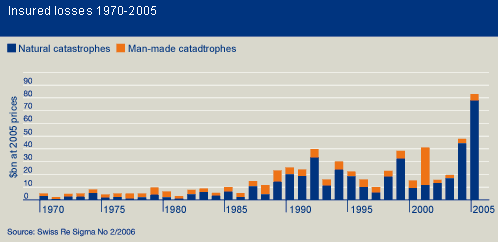2005 industry loss activity
Similar to 2004, until the arrival of the hurricane season, catastrophe loss activity in 2005 had been low, with the largest event loss being the Scandinavian storms in January which are estimated to have cost the insurance industry some US$1.9 billion.
The second consecutive year of very major Atlantic hurricane activity then resulted in 2005 exceeding 2004 as the most costly year on record for insured natural catastrophes. The total insured losses from Hurricanes Katrina, Wilma and Rita are estimated to be up to US$80 billion, double the estimated cost of the 2004 Atlantic hurricanes.
Each of these losses rank among the ten most costly insured losses ever experienced worldwide. The enormity of the losses from Hurricane Katrina were materially affected by the flooding which followed the breaking of the levees built to protect New Orleans from such an event. Also the frequency and size of losses over the last two years is resulting in inflated rebuilding costs or so called demand surge.The total 2005 energy losses are estimated to be several times the worldwide premium for offshore energy installations.
Most expensive insured losses (1970 - 2005)

Recognition of global warming
Windstorms are most likely to pose the greatest near-term insurance industry challenge arising from global warming. With some projecting that the atmospheric levels of the most critical greenhouse gas, carbon dioxide, will double from their pre-industrial levels within the first half of this century, and there being a high correlation between the intensity of hurricanes and surface water temperatures, it is logical to expect over the long term a higher frequency of more intense storms. Indeed, a recent study by Massachusetts Institute of Technology reviewed 50 years of data and found that over that time both the duration and wind speed of hurricanes had increased 50%.
Number of hurricanes per year
This risk highlights the importance of the insurance industry continuing to make progress in the development of its modelling so that exposures can be better managed, as well as the need for continued pressure on insureds to improve compliance with fortified building codes.
Changes in practice
Practices are changing in the London insurance market and the pace of change is set to increase, driven by two forces.
First, regulators are seeking greater transparency in areas where conflicts of interest may reside and, in the UK, the Financial Services Authority has the delivery of "contract certainty" by the industry among its priorities. Contact certainty is about reaching agreement, before the inception of each risk, on the detailed terms of coverage. Historically, this has not been market practice and there are significant merits in achieving the goal, not least of which are the reduced scope for disputes over coverage and improved customer service.
Second, the major insurance brokers have lost a source of revenue as a result of agreements reached with the New York Attorney General following his investigation into commission payments and this has focused their attention even more on driving unnecessary costs out of the risk placement and claims settlement processes. In 2005, both Aon and Marsh have announced major restructuring programmes as part of this aim. Insurers, such as Amlin, are intent on working to help drive out unnecessary cost, so that they remain attractive markets for the placement of brokers' business.
|